


Muzzleloading Accuracy: Why We Still Dearly Need to Work Up Loads
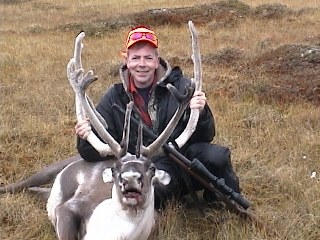
The notion of accuracy from a muzzleloader can be a confusing one. Muzzleloader manufacturers like to say it is their rifle. Bullet-makers like to say it is the bullet, stockmakers enjoy saying it is the stock, barrel-makers suggest it is the barrel, trigger makers tout their triggers, scope brands often tout the accuracy of the scope, powder manufacturers sometimes insist that it is the propellant. Sound familiar? Yet, no hunting rifle I've ever tested, centerfire, muzzleloader, or slug gun, shoots the same with all loads, not remotely close.
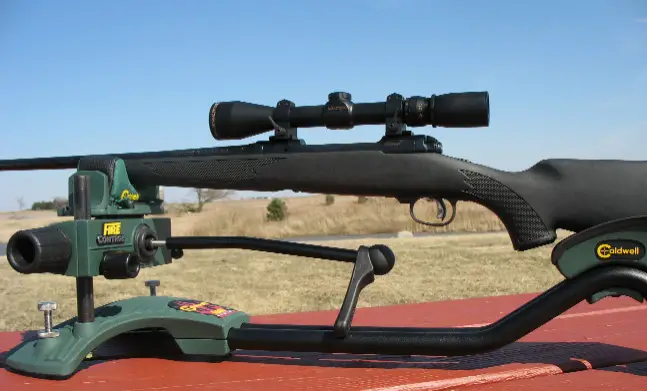
One example is a .30-06 111FCNS Accu-Stock Savage bolt-action. With Winchester 180 grain Supreme Elite cartridges, it threw groups as large as 8.9 inches center-to-center. If that was the only ammo tried in the gun, well . . . anyone would be disappointed with such dismal results. Yet, the very same rifle on the very same day shot like a laser with 150 grain Nosler Ballistic tips, including the one tenth of one inch CTC 5 shot group @ 100 yards, shown below.
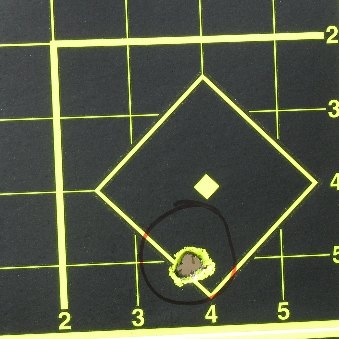
There are a dozen or so case histories reported in just the last week that illuminates this. A couple of examples are one Savage 10ML-II shooter using a “MAX” load that was using pushing a Barnes 300 gr. MZ-Expander and had “poor accuracy.” Dropping 5 grains by weight of propellant, with no other changes whatsoever, his gun now groups MOA @ 100 yards. Another shooter reported “The load shoots flat, but the groups were not all that impressive. Shortly after somebody said they were going to use xxx. I thought maybe I'd back it down to xxx grains. Today I started out with xxx grains - more insanity. Once I switched to xxx grains the group was tight and I was cured!"
Another
example is from Del Ramsey of MMP sabots, who has a friend with an Encore
that refused to group any better than 3 inches. Del's friend was frustrated,
to say the least. Yet, he tried nothing other than two pellets. A change
to 90 grains by volume of loose powder, and viola: group size was instantly
cut in half, to 1-1/2 inches.
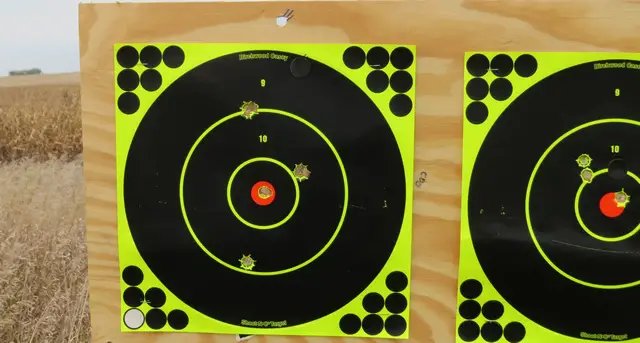
Same load, same model of slug gun. Poor accuracy (left) out of a stainless Savage 220, yet good accuracy out of a blued Savage 220.
Another example is Hornady's 20 GA Superformance® Slug 250 gr MonoFlex® load, out of a Savage 220 slug gun. Tried in a stainless steel Savage 220, it wouldn't do anything I'd call a group, more of a pattern than anything else. Yet, the very same day out of a blued Savage 220, it grouped right at an inch more often than not, and refused to produce a poor group. Yet, in the stainless Savage 220, it was a 6 – 7 inch load. I have no neat and clean explanation for this, nor does anyone.
It isn't a good idea to get obsessed with a muzzle velocity number; though it is an easy trap to fall into. Some of it is the hoary, peculiar notion that the harder a rifle kicks you, the harder it will whack a game animal. We sure don't shoot our game at the muzzle, and 100 fps at the muzzle either way is meaningless at 150 yards from a lethality standpoint with the relatively heavy, large caliber projectiles that we use. I'm not allergic to muzzle velocity, either, nor am I suggesting that anyone should be. It is just that velocity at the expense of repeatable accuracy (or reliability) is an abysmally poor trade-off. Remember, I've shot worse groups than you have.
Long range aficionados might be surprised that the muzzleloading longest shot of late was a 715 yard one shot kill of a pronghorn. The muzzle velocity wasn't the highest, it was around 2200 fps. It sure wasn't me, for my own longest muzzleloading shot was also a pronghorn, but at 287 yards. For other game, it isn't much problem getting closer unless you are the world's worst hunter or in the worst hunting areas that can be found. Four hundred yard shots are not uncommon when it is a depredation situation, but that is a very, very long ways from actually hunting. What your own personal hunting area of effectiveness only you can say, as verified by practice in conditions that approximate your own, unique, hunting conditions for you.
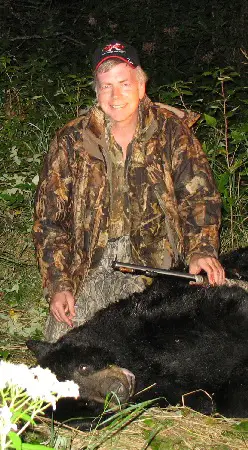
ACCURACY GENERALIZATIONS
Action Type
There is little dispute that a bolt-action rifle with a one-piece stock, two action screws, and a recoil lug has the greatest accuracy potential. It is no guarantee, by any means, and it certainly does not mean that break-actions are not capable of more accuracy than you can use in the field. Nevertheless, a rigid bolt-action in a rigid one piece stock is the best platform to extract accuracy from, having fast locktimes that make them easier to shoot accurately as well.
Propellant
Loose powder can be more accurate than pellets with no question. This does not at all suggest that using pellets cannot produce acceptable or excellent accuracy, for they can. It is just that you cannot work up a load properly with pellets, it is a simple “pass / fail” scenario. Using loose powder allows you to work up a load in 5 grain volumetric units easily, finding the accuracy level, velocity level, and recoil level that you personally prefer.
Bullet-Sabot
Saboted bullets have better trajectories than bore-size bullets in a .50 caliber muzzleloader: the difference is easy to see, for it is .45 caliber ballistics compared to .50 caliber ballistics. The bullet dressed in a sabot needs to fit your bore, though, one of the reasons MMP makes over 30 different types of sabots. Sabots aren't hard to load at all, a pervasive myth.
The word sabot means “shoe,” so the notion that they are hard to load is like asking the question, “Are my shoes too tight or are my feet too big?” Bullet diameters vary, as do barrel diameters, so we need to find the sabot that matches the bullet and the bore, a one-time task. http://randywakeman.com/MuzzleloadingWithBarnes.htm covers sabot selection, with Barnes bullets.
Copyright 2014 by Randy Wakeman. All Rights Reserved.



